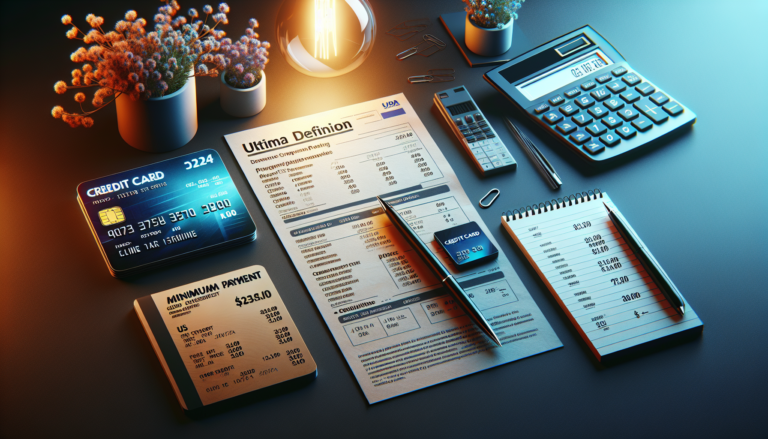Managing credit card debt is a critical aspect of maintaining financial health. One key concept to grasp is the credit card minimum payment – the smallest amount you must pay each month to keep your account in good standing. Understanding how minimum payments are calculated can help you make informed decisions about your credit card usage and debt management strategies.
In this article, we’ll dive into the factors that influence minimum payment calculations, common methods used by credit card issuers, and the potential consequences of only making the minimum payment each month. We’ll also explore strategies for effectively managing your credit card payments and staying on top of your financial obligations.
Introduction to Credit Card Minimum Payments
What is a Credit Card Minimum Payment?
A credit card minimum payment is the lowest amount you’re required to pay each month to maintain your account in good standing. This amount is determined by your credit card issuer and is typically calculated as a percentage of your outstanding balance, plus any interest charges and applicable fees.
It’s important to note that while making the minimum payment will help you avoid late fees and penalties, it’s not an effective strategy for paying off your credit card debt in a timely manner. In fact, consistently paying only the minimum can lead to prolonged debt and substantial interest charges over time.
Importance of Understanding Minimum Payments
Grasping how minimum payments work is crucial for several reasons:
- It allows you to budget effectively and ensure you can meet your monthly payment obligations.
- Understanding the long-term implications of making only the minimum payment can motivate you to pay more when possible, helping you save on interest and become debt-free faster.
- Knowing how your payment behavior impacts your credit score can encourage responsible credit usage and timely payments.
By educating yourself about minimum payments, you’ll be better equipped to make smart financial decisions and avoid the pitfalls of excessive credit card debt.
Factors Influencing Credit Card Minimum Payments
Several key factors come into play when credit card issuers calculate your minimum payment each month:
Outstanding Balance
Your outstanding balance, or the total amount you owe on your credit card, is the primary factor in determining your minimum payment. Generally, the higher your balance, the higher your minimum payment will be.
Credit card issuers typically set a minimum payment that is a percentage of your total balance, often ranging from 1% to 3%. For example, if your balance is $1,000 and your issuer requires a 2% minimum payment, you’d owe at least $20 that month.
Interest Rates and APR
Your credit card’s interest rate, expressed as an annual percentage rate (APR), also impacts your minimum payment. The higher your APR, the more interest you’ll accrue on your outstanding balance each month.
This accrued interest is added to your minimum payment, increasing the amount you must pay to remain in good standing. If you carry a balance from month to month, high interest rates can cause your minimum payments to grow over time, making it more challenging to pay down your debt.
Applicable Fees
Late payment fees, annual fees, and other charges assessed by your credit card issuer can also influence your minimum payment. These fees are typically added to your outstanding balance, which in turn increases the minimum amount due.
For instance, if you miss a payment deadline and incur a $35 late fee, that fee will be tacked onto your balance. As a result, your minimum payment for the following month will be calculated based on your original balance plus the $35 fee.
Common Methods for Calculating Minimum Payments
While specific formulas may vary by issuer, there are two primary methods credit card companies use to calculate minimum payments:
Flat Percentage of the Balance
Many credit card issuers simply require a flat percentage of your total outstanding balance as the minimum payment. This percentage often falls between 1% and 3%.
To illustrate, let’s say your credit card balance is $5,000, and your issuer calculates the minimum payment as 2% of the balance. Your minimum payment for that month would be $100 ($5,000 x 0.02).
Keep in mind that this flat percentage method doesn’t account for interest charges or fees, which are typically added to the minimum payment separately.
Percentage Plus Interest and Fees
Some credit card companies use a more complex formula that takes into account your interest charges and any applicable fees for the month. This method involves adding a percentage of your balance (usually 1% to 2%) to the accrued interest and fees.
For example, suppose your credit card balance is $3,000, your issuer charges 1% of the balance, and you’ve accrued $60 in interest and fees for the month. Your minimum payment would be calculated as follows:
- 1% of balance: $3,000 x 0.01 = $30
- Interest and fees: $60
- Total minimum payment: $30 + $60 = $90
This method ensures that your minimum payment covers at least a portion of your principal balance in addition to the monthly interest and fees.
Impact of Paying Only the Minimum Payment
While making the minimum payment each month keeps your account in good standing, it’s essential to understand the potential drawbacks of this approach:
Increased Interest Costs
When you pay only the minimum, a significant portion of your payment goes toward interest charges rather than reducing your principal balance. As a result, you’ll pay more in interest over the life of your credit card debt.
The higher your interest rate, the more pronounced this effect becomes. In some cases, making only the minimum payment can cause your balance to grow over time, even if you don’t make any new purchases.
Prolonged Debt Repayment
Paying just the minimum extends the time it takes to eliminate your credit card debt. Depending on your balance and interest rate, it could take years or even decades to pay off your debt with minimum payments alone.
To illustrate, consider a credit card with a $5,000 balance and an 18% APR. If you make only the minimum payment of 2% each month, it would take you more than 30 years to pay off the debt, and you’d pay over $7,000 in interest charges.
Potential Penalties
Some credit card issuers may impose penalties or increase your interest rate if you consistently make only the minimum payment. These actions can further compound the financial burden of your credit card debt.
Additionally, carrying high balances and making minimum payments can negatively impact your credit utilization ratio, which is a key factor in determining your credit score. A lower credit score can make it more difficult to secure favorable terms on future loans or credit applications.
Strategies for Managing Credit Card Payments
To minimize the long-term costs of credit card debt and maintain a healthy credit profile, consider implementing these strategies:
Budgeting and Financial Planning
Create a budget that allocates funds for your monthly credit card payments. Aim to pay more than the minimum whenever possible to reduce your balance and save on interest charges.
Prioritize paying off high-interest credit card debt first, as these balances have the most significant impact on your overall financial well-being.
Paying More Than the Minimum
Whenever your budget allows, pay more than the required minimum payment. Even small additional payments can make a significant difference in the long run.
To see the impact, let’s revisit the earlier example of a $5,000 balance with an 18% APR. If you increase your monthly payment to 3% of the balance instead of 2%, you’d pay off the debt in about 17 years and save over $3,000 in interest charges.
Making Multiple Payments in a Month
Consider making bi-weekly or weekly payments instead of one lump sum payment each month. This strategy can help you stay on top of your debt and reduce your average daily balance, which is used to calculate interest charges.
By paying more frequently, you’ll reduce the amount of interest that accrues between payments, ultimately saving you money and helping you become debt-free faster.
Consequences of Late Payments
Failing to make at least the minimum payment by the due date can lead to several negative consequences:
Late Payment Fees
Most credit card issuers charge a late payment fee if you miss the due date. These fees can be substantial, often ranging from $25 to $40 or more.
Late fees are added to your outstanding balance, increasing the total amount you owe and potentially leading to higher minimum payments in the future.
Impact on Credit Score
Late payments can significantly damage your credit score, as payment history is one of the most important factors in credit scoring models. A single late payment can cause your score to drop by dozens of points, making it more difficult to secure favorable credit terms in the future.
The longer a payment remains delinquent, the more severe the impact on your credit score. Payments that are 30, 60, or 90 days late can have increasingly negative effects on your credit profile.
Tips for Staying on Top of Credit Card Payments
To avoid the pitfalls of late payments and ensure you’re making progress in managing your credit card debt, consider these tips:
Regularly Reviewing Credit Card Statements
Make a habit of reviewing your credit card statements each month. This practice allows you to track your spending, identify any errors or unauthorized charges, and stay aware of your payment due dates and minimum payment amounts.
By staying engaged with your credit card accounts, you’ll be better equipped to make informed decisions about your spending and debt management strategies.
Setting Up Automatic Payments
Consider setting up automatic payments through your credit card issuer or bank. This approach ensures that at least the minimum payment is made each month, helping you avoid late fees and negative impacts on your credit score.
If possible, set your automatic payment to be higher than the minimum to make progress in paying down your balance. Just be sure to monitor your bank account to ensure sufficient funds are available each month.
Conclusion: Making Informed Financial Decisions
Understanding how credit card minimum payments are calculated is a crucial step in managing your debt effectively. By grasping the factors that influence your minimum payment, the consequences of making only the minimum, and strategies for staying on top of your obligations, you can make informed decisions about your credit card usage and debt repayment plan.
Remember, while making the minimum payment can keep your account in good standing, it’s rarely the most effective approach for long-term financial health. Whenever possible, pay more than the minimum, make frequent payments, and prioritize paying off high-interest debt to save money and become debt-free faster.
By taking control of your credit card debt and making smart financial decisions, you can improve your credit profile, reduce financial stress, and work towards a more stable financial future.
See also:






